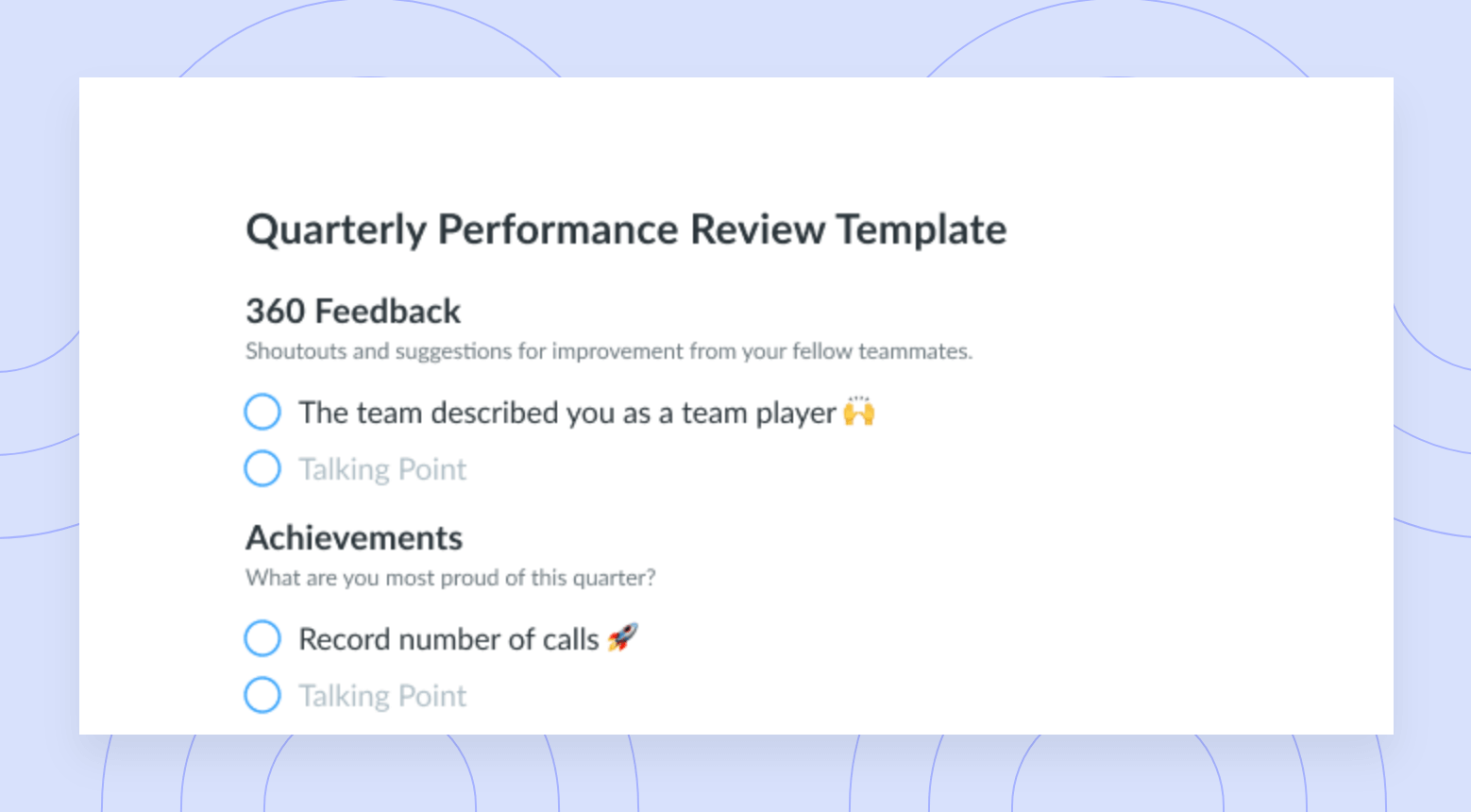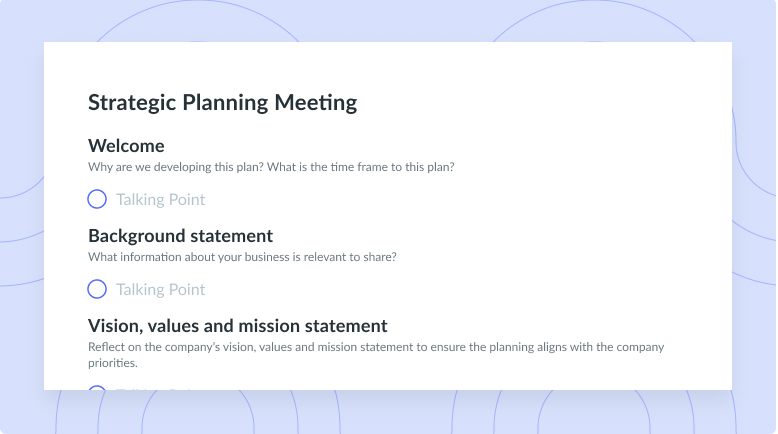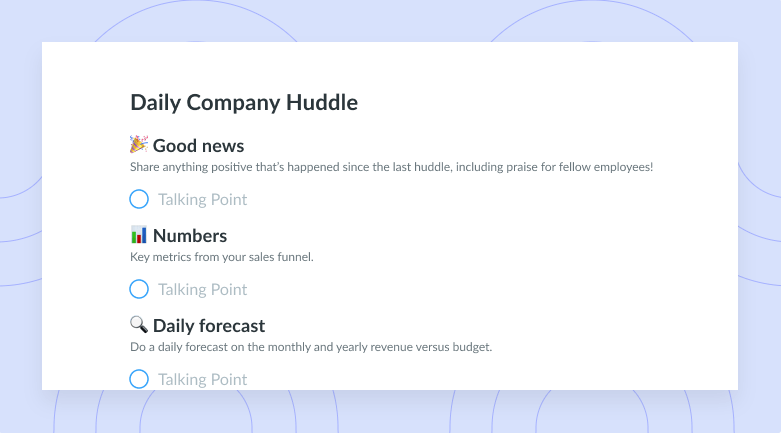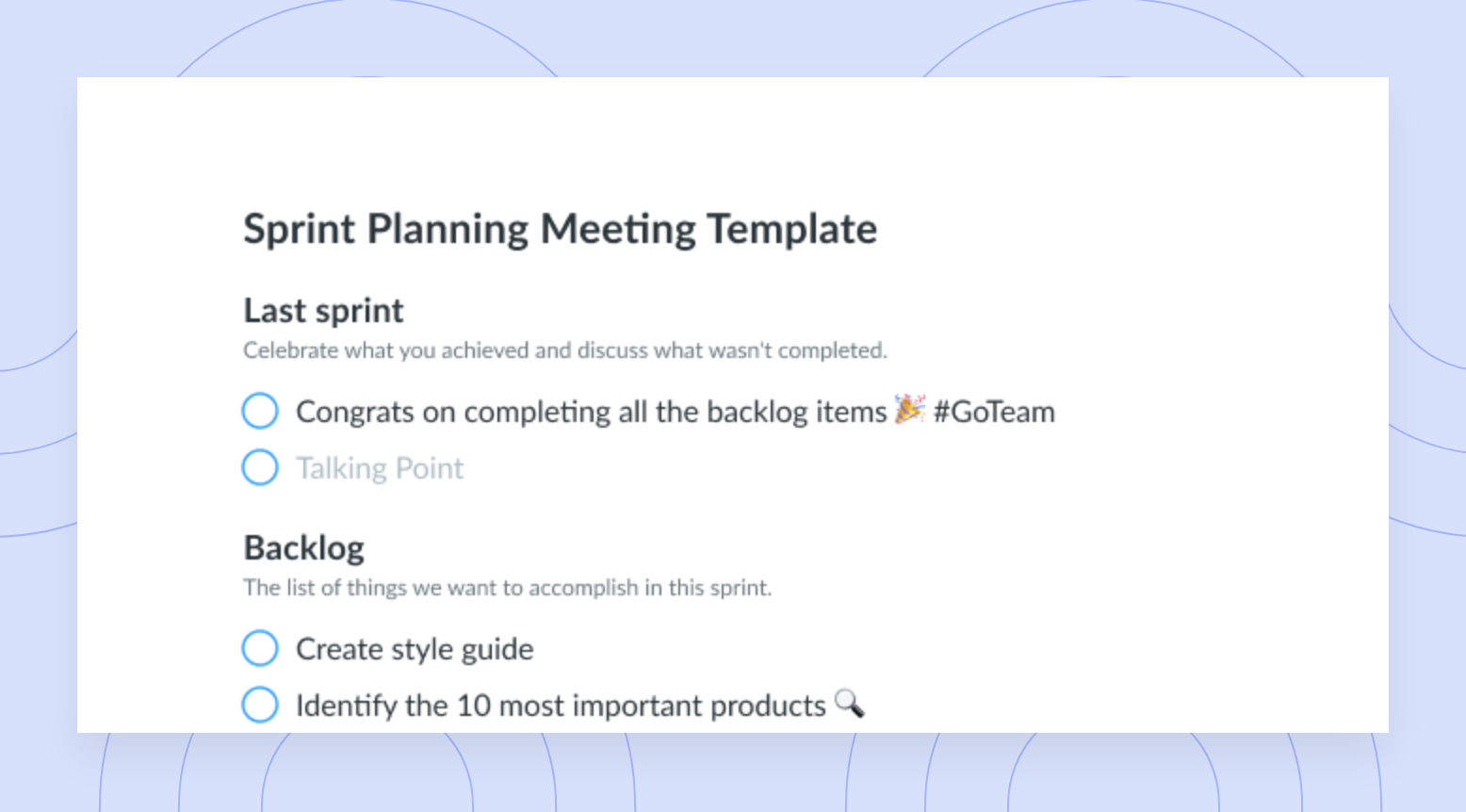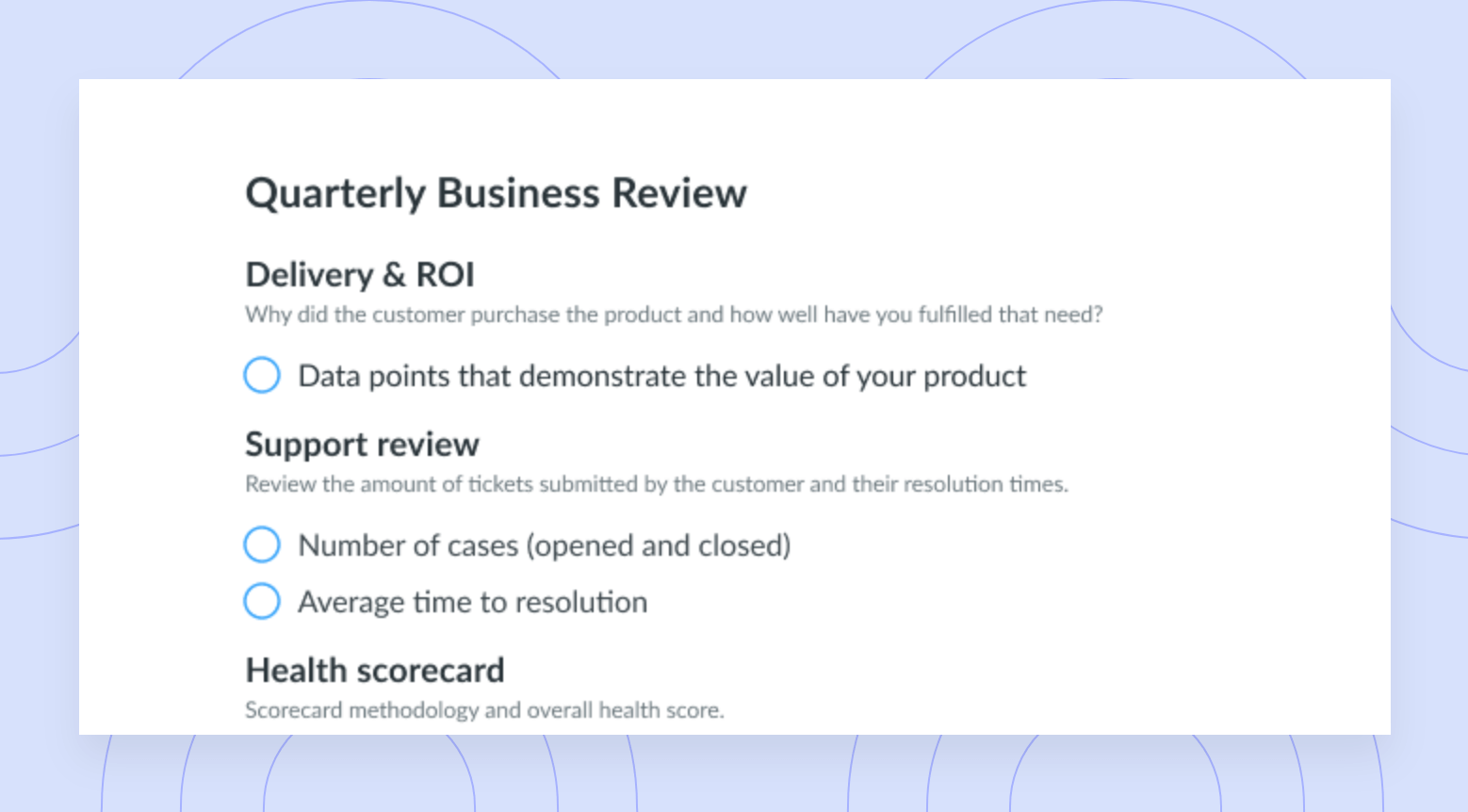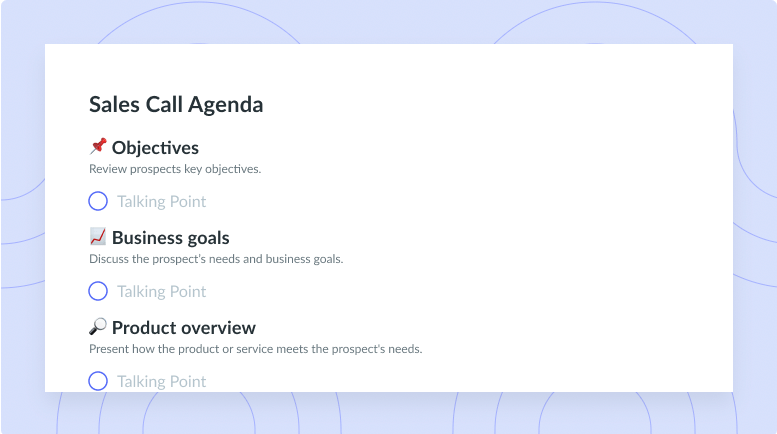Quarterly Planning: Ultimate Guide for 2024 [+Free Template]
Knowing how to use quarterly planning can keep your team members invested, energized, and ready to crush their goals!
Businesses are expected to undergo a lot of growth in 2023, according to Forbes. From drastic changes in how investors are approaching new deals, to the emergence of more new technologies that will affect how businesses operate, a lot is going on.
Deciding early on what strategy your business will take in 2023 can encourage you to maintain focus on your goals and reach success. Feeling like that’s still a lot to do? Quarterly planning might be able to help.
- What is quarterly planning?
- Why is quarterly planning important?
- The difference between quarterly and annual planning
- How to run a quarterly planning meeting
- Free quarterly planning template
- Frequently asked questions about quarterly planning
What is quarterly planning?
Many companies choose to operate in quarters, meaning they use three-month periods for planning and tracking projects. Within this three-month window, the team sets specific goals that it hopes to achieve within that time. Across a fiscal year, there are four quarters, so ideally, each quarter seeks more progress or a higher end goal (i.e., higher sales quota) than the previous quarter. At the end of all four quarters, the team should meet the annual goal. The standard organization of quarters is:
- January, February, and March are the first quarter
- April, May, and June are the second quarter
- July, August, and September are the third quarter
- October, November, and December are the fourth quarter
Note that the organization of quarters may differ at your company based on when your fiscal year starts and ends.
Why is quarterly planning important?
Many teams prefer working with quarters for several reasons. First, imagining how you’ll tackle an entire fiscal year is a daunting task. However, looking at three-month segments feels a whole lot more manageable. You can also opt to look at quarterly planning as breaking out four stages of a year-long plan (each quarter is one “stage” within the fiscal year plan). This is incredibly helpful for managers who need to break down a complex strategy into actionable, tactical goals for their team. As a bonus, having goals to achieve by the end of each quarter keeps the team’s adrenaline high and provides more opportunities to incentivize employees. In quarterly planning, you offer your team at least four times a year to receive incentives, rather than just once at the end of the fiscal year.

Track objectives as part of your meeting workflow
Stay on top of your team’s goals by clearly recording, defining, and tracking the progress of your OKRs in Fellow’s Objectives tool. Try Fellow today!

The difference between quarterly and annual planning
On one hand, annual planning looks at all the things that need to be completed by the end of the fiscal year. It doesn’t necessarily break out specific execution and implementation plans for a specific period. As such, it can be more difficult to measure progress or success. On the other hand, quarter plans are three-month segments of work with end goals that need to be completed at the end of each quarter. Quarterly plans are more specific and tactical, as they fit into the overarching, strategic annual plans.
How to run a quarterly planning meeting
- State the meeting purpose
- Review the previous year
- Brainstorm for the year ahead
- Keep budget and benchmarks in mind
- Create objectives
- Set timelines and action items
- Delegate tasks
1State the meeting purpose
It’s essential to know why you’re running or attending any meeting. If you’re joining a call without a plan, you likely won’t get the information or have the conversation that was originally needed. In other words, it will be time wasted.
Declaring the meeting purpose in a statement helps you and your attendees make the most of your time together since it allows all meeting participants to prepare relevant talking points and add them to a shared meeting agenda, and reminds them to bring any documents—like progress reports, strategic goal maps, or resource requirement lists—that need to be presented on the call.
2Review the previous year
Looking back at the previous year and quarter helps plan for the future. Take a bit of time early in your meeting to discuss:
- What went well? Why did this go so well?
- What went wrong? What caused the issues?
- If you could go back and make changes, what would you do differently?
- How will we apply those learnings in our next quarter?
It’s important to get thoughts on these questions from every member of your team, as they may each have different insights and learnings. It might also be helpful to ask your team to prepare presentations or reports of progress in the past year. Not only can this boost motivation to see how far your team has come so far, but it can also provide benchmarks for improvement in the next quarter.
3Brainstorm for the year ahead
Brainstorming can happen in a lot of ways. Depending on your team’s size and their various personalities, you might choose one of many ways to brainstorm ideas for the year ahead. Try to choose a brainstorming method that encourages all meeting attendees to speak up, especially if the activities in the next year will greatly impact their day-to-day work. Some things to start thinking about are:
- What activities do we want to conduct in the next year?
- What problems do we want to solve?
- What risks are we willing to take?
- What information have we learned that we can find a way to use?
4Keep budget and benchmarks in mind
Let the brainstorming time be for dreaming to the far-out ends of the world where money is limitless and time is infinite. But after your list of ideas is stacked high, consider bringing it back to real life to narrow down your pile. Making sure that your ideas are realistic based on your budget and starting benchmarks is helpful to ensure that you can actually reach success. Teams will feel much more motivated working towards goals that feel attainable, rather than feeling like they are unlikely to reach an extreme “stretch” goal.
Budget is important here, too. It’s best to have your overarching umbrella approved or provided by your finance team before your quarterly planning meeting. This way, you can make decisions on which activities to pursue in the meeting, rather than waiting for approval at a later time.
5Create objectives
Once your team has decided on a select number of activities to pursue, you should dedicate time to identifying how success will be measured for each activity. Objective and key result (OKR) methodology is a goal-planning approach to connect tactical goals to strategies.
Over the year, there will be a lot of OKRs to oversee. Use a tool like Fellow to track which OKRs you are focusing on in each quarter. Fellow helps you document the progress of your goals, plus lets you quickly review those objectives during meetings!
6Set timelines and action items
SMART goals are specific, measurable, achievable, realistic, and have timelines. Some objectives, such as “earning 15% more leads,” for example, require a time period to measure against so you know if this period outperformed the last one.
Implementing action items at the end of each quarterly planning meeting ensures that your team members can be held accountable for their project tasks. Action items can be anything that needs to be done following the meeting, including:
- Following up with someone for information
- Securing budget approval
- Researching a list of requirements
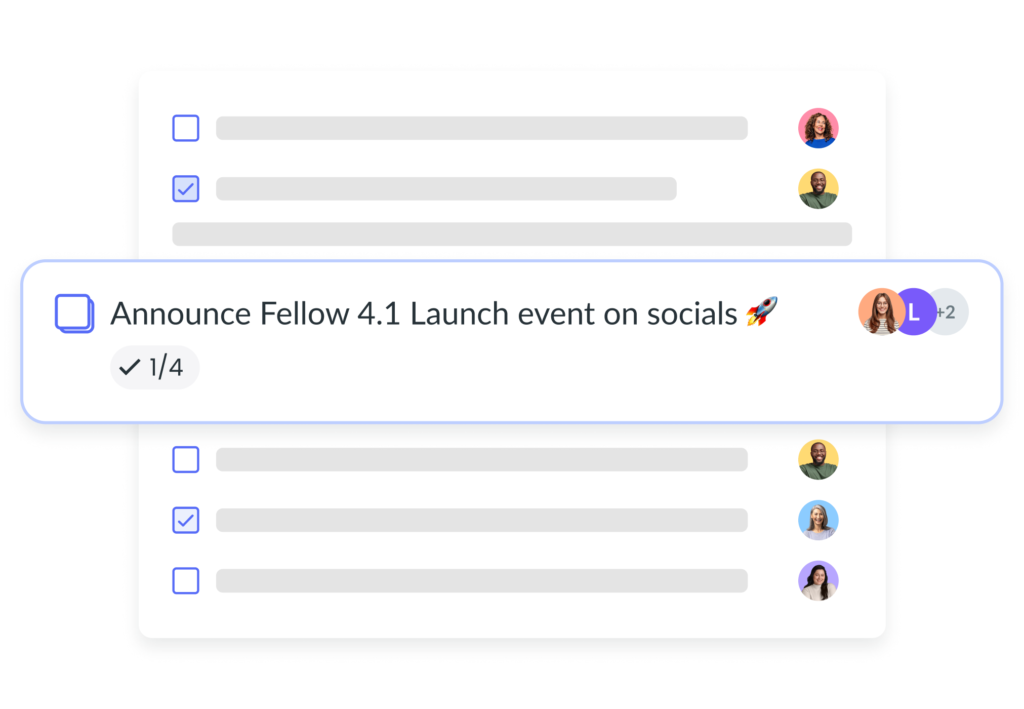
7Delegate tasks
Finally, make sure that your team members know what they’re responsible for. Delegating tasks to individuals or smaller team segments passes ownership from you, as the leader, to your team. This is a great way to make your team feel motivated and engaged in the activities. Additionally, delegating is an ideal way to offer professional development opportunities! For example, look for team members who are showing more leadership traits, and offer them action items where they need to coordinate multiple team members or departments. Track who has been assigned each task so they can follow up with progress updates in future meetings.
Free quarterly planning template
It can be tricky to start quarterly planning for the first time. Try using this template to lead your first quarterly planning meeting so you can focus on bringing in those great ideas!
Frequently asked questions about quarterly planning
- How long do quarterly planning meetings take?
- When should quarterly planning meetings be held?
- Who should be involved in quarterly planning?
- How can you keep your team members accountable?
1How long do quarterly planning meetings take?
These meetings are very valuable and are the foundation for your quarter’s success, so ideally you should block out at least one hour for this meeting. If your meeting is too short, you might not cover all the planning topics. If the meeting is too long, you risk tiring your team out too soon. Consider breaking up the meeting into multiple sessions if you need more than one hour.
2When should quarterly planning meetings be held?
Before the new fiscal year, you will likely hold one meeting to go over each quarter at a high level. Then, hold another meeting before each quarter to check in on strategy and make more detailed plans. Consider doing progress updates every month throughout the quarter, to see if the plans are on track or need to be adjusted.
3Who should be involved in quarterly planning?
Quarterly plans will be interpreted and used at all levels. Company-wide quarterly plans only need to involve C-level or senior managers, and the determined plans can be relayed to individual teams. Each team can host their own quarterly planning meetings for more specific tactics, and only the team lead and direct team members should be involved. Avoid inviting too many people, and avoid inviting those who aren’t involved in the execution of the activities.
4How can you keep your team members accountable?
It can be tricky! End-of-quarter incentives and extra-large surprises for achieving stretch goals can keep your team motivated. Giving your team members ownership over action items will help maintain a sense of purpose, keeping them engaged in the plans. If you’re having issues keeping individuals accountable, try approaching these issues directly in a one-on-one meeting.
Parting advice
Quarterly planning is a great approach to tackling your annual strategy. You can include almost anything you want within your quarterly planning, but whatever you choose, make sure you’re thinking about how far you can push your team to new, higher goals without making them feel too distant from their targets. Not only does quarterly planning make it more tangible to work in shorter terms, but it also gives you more opportunities to reward your employees for their hard work—so make sure not to forget that, too!
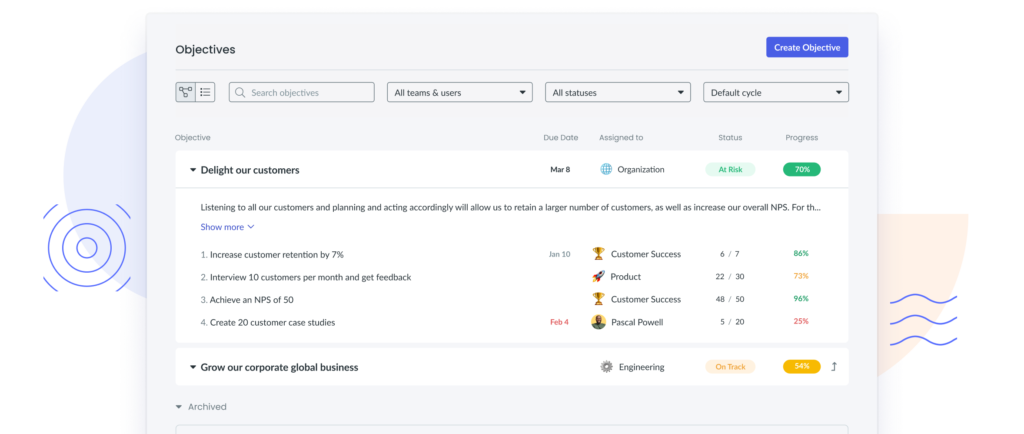
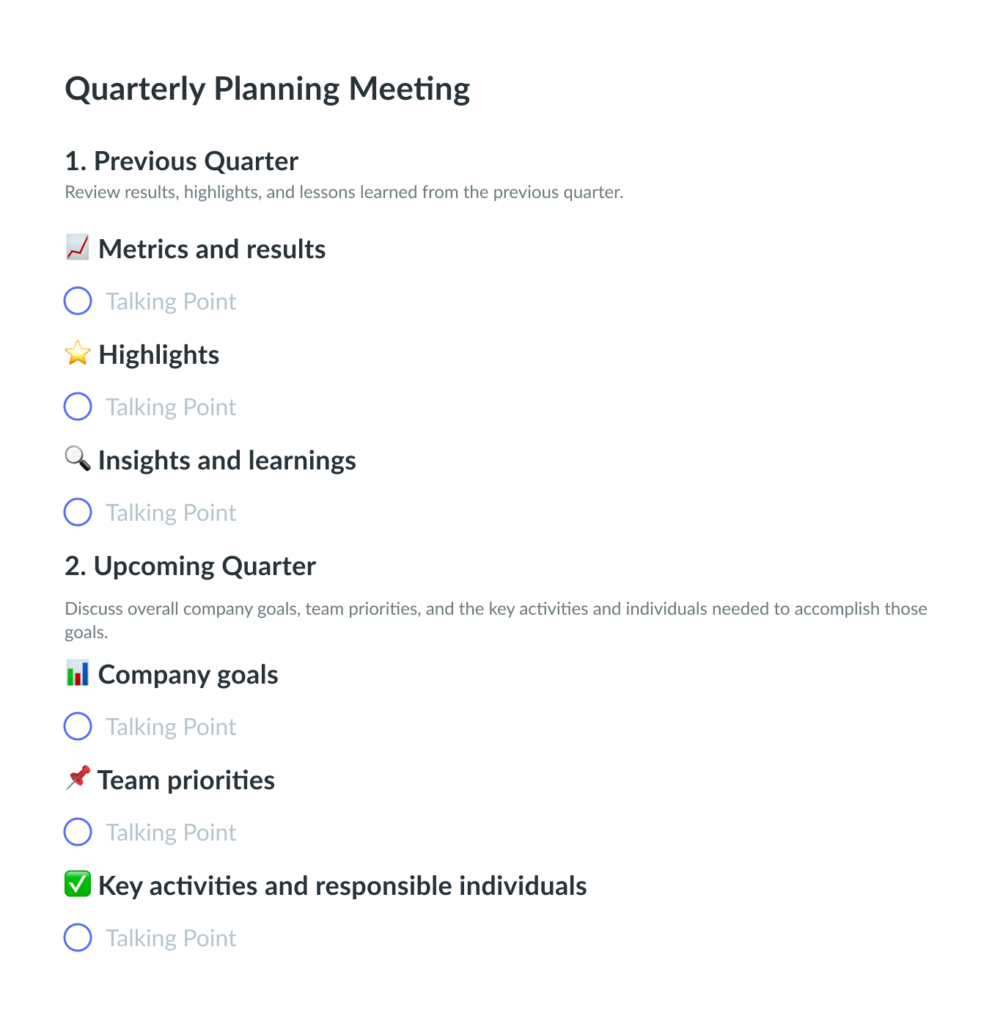




![How to Run a Delightful AGM [+ Free Template]](https://fellow.app/wp-content/uploads/2022/07/How-to-Run-a-Delightful-AGM-2.jpg)
![COO Meeting Agenda: 6 Things to Include & Top Tips [+ Free Templates]](https://fellow.app/wp-content/uploads/2022/06/COO-Meeting.jpg)




